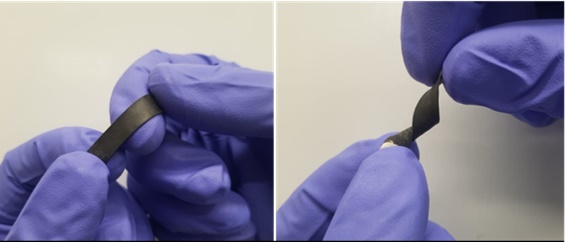
The sensor, developed by the Materials Physics Group at Sussex University, can reportedly stretch up to 80 times higher strain than strain gauges currently available and show resistance changes 100 times greater than the most sensitive materials in research development.
Graphene gives strain sensor added sensitivity for medical monitoring
Strain sensor offers wearable solution for monitoring lung disease
The research team believe the sensors could bring new levels of sensitivity to wearable tech measuring patients’ vital signs and to systems monitoring buildings and bridges’ structural integrity.
In a statement, Marcus O’Mara, from the School of Mathematical and Physical Sciences at Sussex University, said: “The next wave of strain sensing technology uses elastic materials like rubber imbued with conductive materials such as graphene or silver nanoparticles, and has been in development for over a decade now.
“We believe these sensors are a big step forward. When compared to both linear and non-linear strain sensors referenced in the scientific literature, our sensors exhibit the largest absolute change in resistance ever reported.”
Alan Dalton, Professor of Experimental Physics at Sussex University, said: “This promising technology may prove especially useful in established fields such as healthcare, sports performance monitoring and rapidly growing fields such as soft robotics.
“Our research has developed cheap, scalable health monitoring devices that can be calibrated to measure everything from human joint motion to vitals monitoring. Multiple devices could be used across the body of a patient, connected wirelessly and communicating together to provide a live, mobile health diagnostics at a fraction of the current cost.”
The new paper, published in Advanced Functional Materials, details the process for incorporating large quantities of graphene nanosheets into a PDMS matrix in a structured, controllable fashion that results in excellent electromechanical properties.
The authors said the method has the potential to be extended to a wide range of two-dimensional layered materials and polymer matrices. The sensors are said to deliver greatly enhanced conductivity at all measured loading levels with no apparent percolation threshold.
Commercial gauge devices suffer from relatively low sensitivity and strain range, with gauge factors ranging from 2-5 and maximum strains of five per cent strain or less, resulting in the resistance increasing by less than 25 per cent and preventing high-strain sensing required for bodily motion monitoring.
The new sensors are able to detect strains less than 0.1 per cent, due to their higher gauge factor of ~20, and up to 80 per cent strain, where the exponential response leads to the resistance changing by a factor of more than one million.
This allows high-sensitivity low-strain sensing for pulse monitoring and high-strain measurement of chest motion and joint bending as a result of the record resistance change.
Dr Sean Ogilvie, Research Fellow in Materials Physics at Sussex University, said: “Commercial strain sensors, typically based on metal foil gauges, favour accuracy and reliability over sensitivity and strain range. Nanocomposites are attractive candidates for next generation strain sensors due to their elasticity, but widespread adoption by industry has been hampered by non-linear effects such as hysteresis and creep due to the liquid like nature of polymers at the nanoscale which makes accurate, repeatable strain readouts an ongoing challenge.
“Our sensors settle into a repeated, predictable pattern which means that we can still extract an accurate read-out of strain despite these effects.”




IEA report claims batteries are ‘changing the game’
Batteries come with major weight penalties in vehicles and to date have only achieved very limited application in the rail sector where range and...